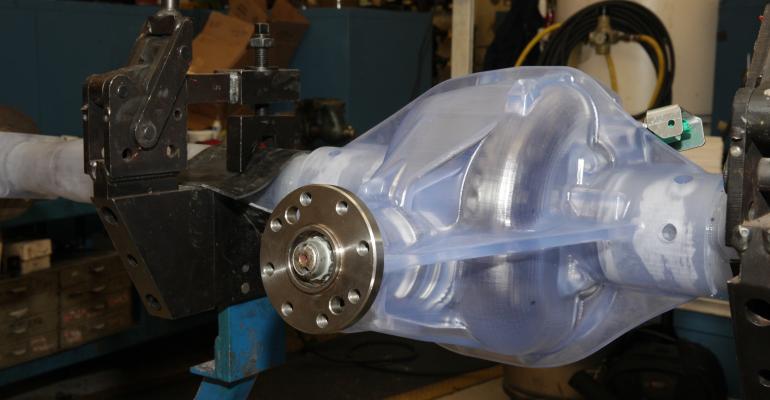FCA US is employing advanced 3D printing to cut development time and the money needed to engineer new vehicle axles, giving the automaker what it believes is a leg up on its competitors.
New-generation, high-temperature resins that have hit the market in the last few years are enabling FCA to 3D print transparent prototype axle housings that allow engineers to see the inner workings of the axle during dynamometer testing and optimize lubrication flow.
Previously, and still the case at most other automakers, FCA engineers had to cut holes in the prototype axle’s housing, install clear Plexiglas covers and peer through the small openings, using flashlights for illumination, in order to ensure lubrication oil was flowing properly.
Printing the housing from clear, new-generation resin capable of withstanding temperatures as high as 140º F (60º C) greatly improves visibility, and it can cut several months off the development process, Tom Sorovetz, FCA casting engineer, tells WardsAuto in an interview.
“The old way, you had to create patterns for the sand castings, create the sand, pour the iron, send it out to be machined, pour the castings and clean them up,” he says. “(Then you had to) machine in those slots for the windows, assemble (the axle) and try to look through it with a flashlight.”
Now, computer-generated designs are sent directly to the lab and the prototype is built within a few days, Sorovetz says.
“So we’re way ahead of the curve compared to where we were a few years ago,” he says.
Maybe even more importantly, the 3D-printing process can slash development costs 33%-42%, Sorovetz estimates.
Once components are machined and polished, the prototype axle assembly is hooked to a dynamometer that can tilt and roll the axle to simulate driving on- and off-road at various speeds and on a variety of grades.
“You can see exactly where the oil is slinging and where it’s not slinging,” Sorovetz says. “So that way you don’t starve a bearing or spline of lubrication. The old way…was extremely difficult to do. With the onslaught of new materials, we were able to turn it into a whole process where we now develop it, we build it and we can run it.”
Among the advantages, the FCA engineer says, is having all the technology needed to produce the prototype axles in-house.
“The nice thing is, at CTC (the Chrysler Tech Center at FCA headquarters in Auburn Hills, MI), the design and engineering community is all under one roof. Not only do we get to collaborate that way, but they can actually come down and see the design on the test stand to see if they think there’s an even better way to perfect something way prior to it getting into production,” Sorovetz says.
FCA began phasing in the 3D printing prototype process for axles in 2009, but the casting engineer says it really wasn’t perfected until a couple years ago. FCA says it has implemented the technology in developing six axle families.
Sorovetz says the process also allows the automaker to incorporate engineering changes on the fly if problems surface in the field or it simply discovers better ways of doing things.
“We can make a modification, build it out of (resin) and have it back on the test stand in a few days,” he says. “The old way…it would take several weeks to a few months.”





